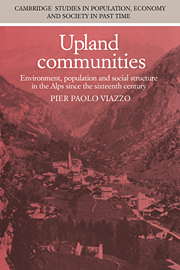 Upland Communities
Upland Communities Published online by Cambridge University Press: 13 October 2009
The changing balance of population and resource
The discussion of Alpine migration patterns contained in the last two chapters has shown that many widespread notions concerning both emigration and immigration are in need of major modification, and that a number of important problems must be considered more carefully than has been the case so far. One such problem is whether permanent emigration actually played a more decisive role than other coping devices used by Alpine populations to strike a viable balance with their resources. The best way of tackling this problem is to verify whether upland communities could approach a homeostatic condition in which mechanisms lowering fertility kept natural increase within tolerable limits, thereby reducing the significance of permanent emigration as a safety valve. Some evidence has already been presented in Chapter 6. But it is now time to examine in a more comprehensive manner both this question and, more generally, the Malthusian model outlined in Chapter 2.
As we have seen, the foundation of Malthus's argument is that in mountain areas the ceiling of resources is easily reached, all the more quickly when for some reason mortality sharply declines, as had apparently been the case in the Swiss Alps in the course of the eighteenth century. It is therefore in the mountains that the check o Indeed, the figures collected by Muret on Leysin and other mountainous parishes of Canton Vaud offered an impressive example of how effective the check of nuptiality could be as a homeostatic mechanism. f nuptiality should be expected ‘to prevail to an unusual extent’. Indeed, the figures collected by Muret on Leysin and other mountainous parishes of Canton Vaud offered an impressive example of how effective the check of nuptiality could be as a homeostatic mechanism.
To save this book to your Kindle, first ensure [email protected] is added to your Approved Personal Document E-mail List under your Personal Document Settings on the Manage Your Content and Devices page of your Amazon account. Then enter the ‘name’ part of your Kindle email address below. Find out more about saving to your Kindle.
Note you can select to save to either the @free.kindle.com or @kindle.com variations. ‘@free.kindle.com’ emails are free but can only be saved to your device when it is connected to wi-fi. ‘@kindle.com’ emails can be delivered even when you are not connected to wi-fi, but note that service fees apply.
Find out more about the Kindle Personal Document Service.
To save content items to your account, please confirm that you agree to abide by our usage policies. If this is the first time you use this feature, you will be asked to authorise Cambridge Core to connect with your account. Find out more about saving content to Dropbox.
To save content items to your account, please confirm that you agree to abide by our usage policies. If this is the first time you use this feature, you will be asked to authorise Cambridge Core to connect with your account. Find out more about saving content to Google Drive.